Interview
Stephanie Alaniz: Into the Wild
“Into the Wild” is a regular interview with early career print artists. Interviews will highlight the varied paths the subjects are taking to strike an accord between life and their artistic practice. Expect a balance of approaches, from those hopping the residency circuit, to those teaching part-time or who snagged the elusive tenure-track gig right out of the gate, or those working a desk job or waiting tables to afford access to a community print shop or maker space. In short, there’s many ways to “make it” and we want to share them all!
Have an idea for a person to interview? Please submit suggestions to the Interviews section of the Submissions portal below.
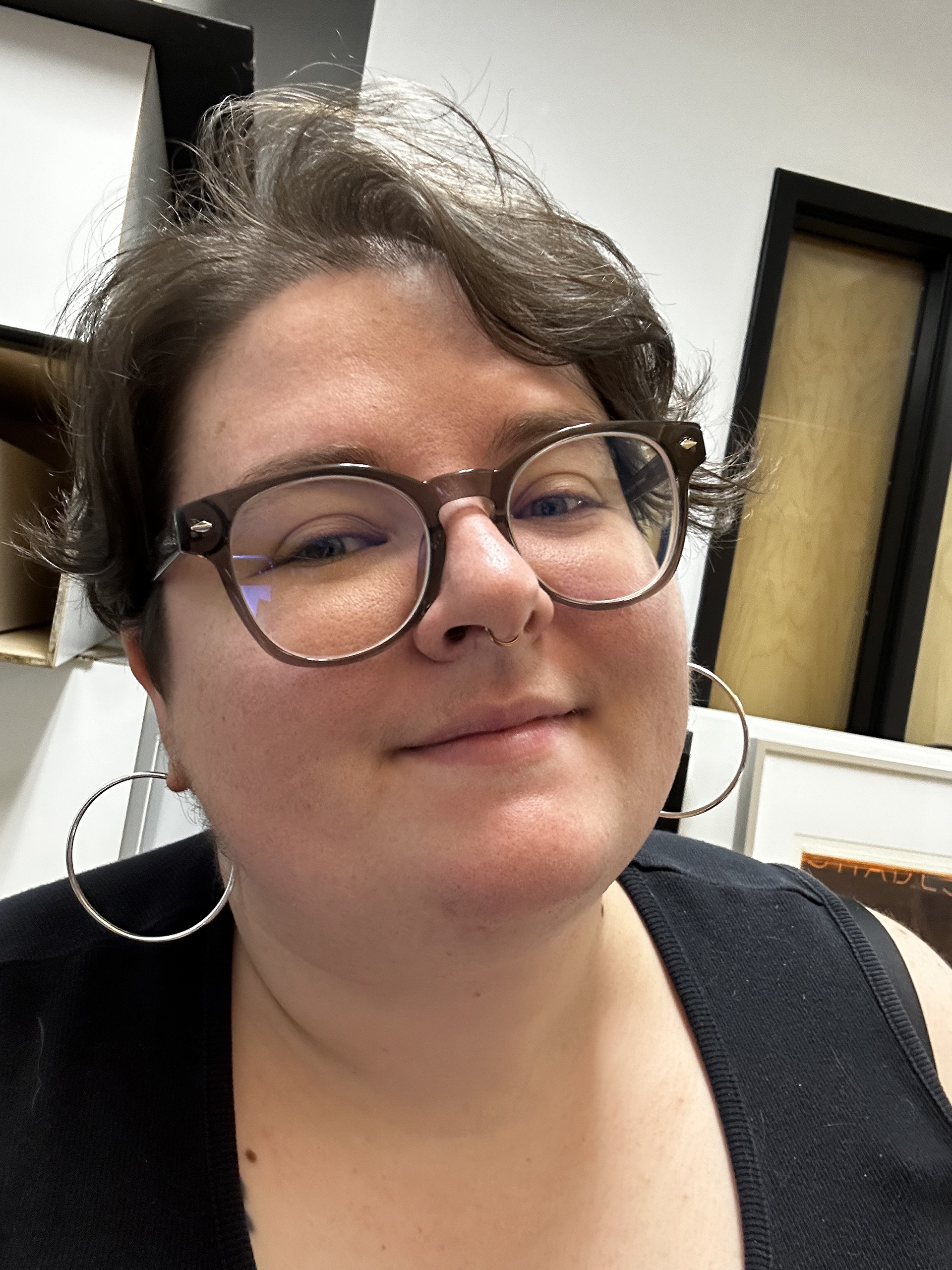
Stephanie Alaniz
Stephanie Alaniz (they/them) was born and raised in South Texas. They received their Bachelor of Fine Arts in 2016 from Texas A&M-Corpus Christi with an emphasis in Printmaking. They then went on to receive their Master of Fine Arts from West Virginia University in 2019. Stephanie’s current work focuses on normalizing insecurities, challenging anti-fat bias, discussing mental health issues, and the intersection of all of these topics. Through printmaking, textiles, drawing, and sculpture they are able to create work about these topics with the hope of inviting the viewer in to reflect on themself and how these topics influence the world around us. Stephanie currently lives in Emporia, Kansas where they are the Gallery and Outreach Director at Emporia State University and teach courses at the Lawrence Arts Center in Lawrence, Kansas.
Artist Statement:
My Fat Quilts series is a love letter to my fellow fatties. In a society that refuses to value us, I want to take this platform and give us a voice to speak and challenge the norm that has been present for the entirety of our lives and beyond. Existing in a larger body in an anti-fat society is incredibly difficult, people are cruel and hurtful and often treat fat people as if they are the lowest form of life. The use of the word “fat” has been taken back by the fat activist community as a descriptor rather than a negative. This work’s intention is to challenge the social norms while deconstructing how we see fat bodies so that we can reconstruct our views through a lens of radical kindness, empathy, and understanding. These large scale quilts feature relief prints on fabric that are then appliquéd to larger quilt tops and assembled quilts.
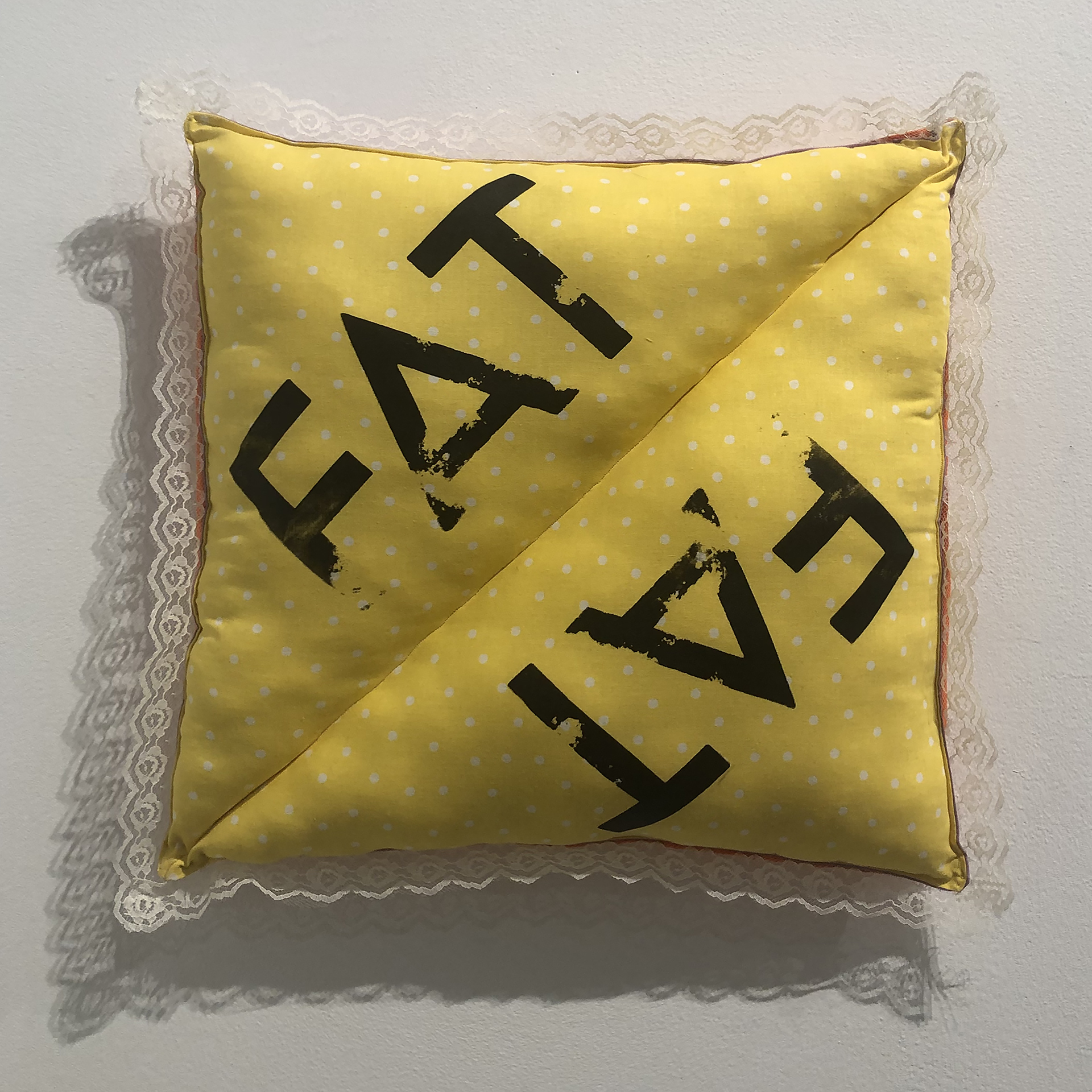
Too Fat
Screenprint on fabric
12” x 12” x 3”
2023
The Interview
Blake Sanders: You began your academic journey at Texas A&M-Corpus Christi. How did you choose to attend this particular program? How did your college experience reinforce or provide contrast to growing up in South Texas? When did you discover the printmaking program, and how did it introduce you to the broader printmaking community?
Stephanie Alaniz:
When I started college I actually attended a community college in Corpus Christi, Texas called Del Mar College. It was here I had a “sampler” of printmaking as I took a printmaking course there and had no idea what printmaking even was. I assumed it had to do with digital printers. When I started class I was surprised when we did a woodcut, linocut, intaglio, and lithography! I actually struggled with the litho part because I only had two weeks to do it and I wasn’t happy with how my drawing turned out with the crayon. So my plan was always to get my basics done at Del Mar and then transfer to TAMUCC to finish out my BFA. I didn’t receive a degree from the community college so I just transferred and when I started I assumed I would be a painting concentration because I didn’t know any other mediums and I felt kind of bored with drawing even though I love it. I just needed a challenge when it came to drawing, I guess. My second semester I signed up for Intermediate Printmaking and was excited because I knew that we would get to do screenprinting and I hadn’t done that yet. My professor Ryan O’Malley then announced it would be the first time Intermediate Printmaking focused on one process and it was lithography. I was genuinely so upset because I had already done litho and I had such a rough time that I didn’t think I’d like doing it more. I know this is silly…but Ryan demo’d sharpening the crayon and that changed EVERYTHING! I had no idea it could be sharpened and that’s why my first litho was so bad because my crayon was just a round/flat nub I was drawing with haha! So silly. So I fell in love with litho then and fully immersed myself in trying to understand it.
I think the thing you experience most in my part of south Texas, which is the gulf coast area, is that the ocean is a major focal point of the area. So when I started I was making lots of work with sea creatures that honestly did not have any major meanings behind them other than just not knowing what else to do. Another contrast of college versus the small town I came from was that many people were more progressive and supportive of one another. I know that I grew up experiencing and perpetuating misogyny, sexism, and definitely racism as a result of what was around me and who. Starting at TAMUCC was the beginning of me being a better person and having those experiences challenged. One of the grad students, Dan Heskamp’s work is about animal rights and Dan is a vegetarian. I always felt weird about eating meat but didn’t know what not eating meat would be like and through my friendship with Dan they opened my eyes to the cruelty that is happening in the meat industry, the climate impact, and overall ethical nature so I became a vegetarian! This is just one of many ways that being in this space impacted me. It also opened my eyes to how many of the things I experienced as a child were problematic and challenging, which I had begun making work about for my BFA.
One of the most amazing experiences I had at TAMUCC was the community. All the undergrads and grads while I was there were very close and we did lots of activities together, but more specifically we worked together in the studio and assisted one another in making work. We leaned on each other in our times of need. I am a very social person and love being in the studio making work alongside others, it fills me with joy. Additionally, Ryan brings out lots of visiting artists that we get to assist in making work with as part of Full Court Press, TAMUCC printmakings print publication Ryan runs. During my Intermediate Printmaking class Kathryn Polk was actually a visiting artist and I was so drawn to her work and her as a person, she’s truly so kind, humble, and a joy to work with! Assisting printmakers also solidified my love of teaching/helping others to create their artwork. Because Ryan is a student of Llyod Menard, I was encouraged to go to Frogman’s Print Workshop in 2014 when I took Carrie Lingscheit’s mezzotint class. This was LIFE CHANGING! The people I met were so kind and supportive but also being exposed to artist lectures about the content and process of their work pushed me to think more about the content and intention in my own work. I have been attending Frogman’s for the last 10 years (minus COVID and I missed last year unfortunately). It is one of my favorite printmaking organizations and I can’t recommend it enough. This full obsession with print also brought me to conferences such as SGCI, and events such as It Came From the Bayou and Print Austin.
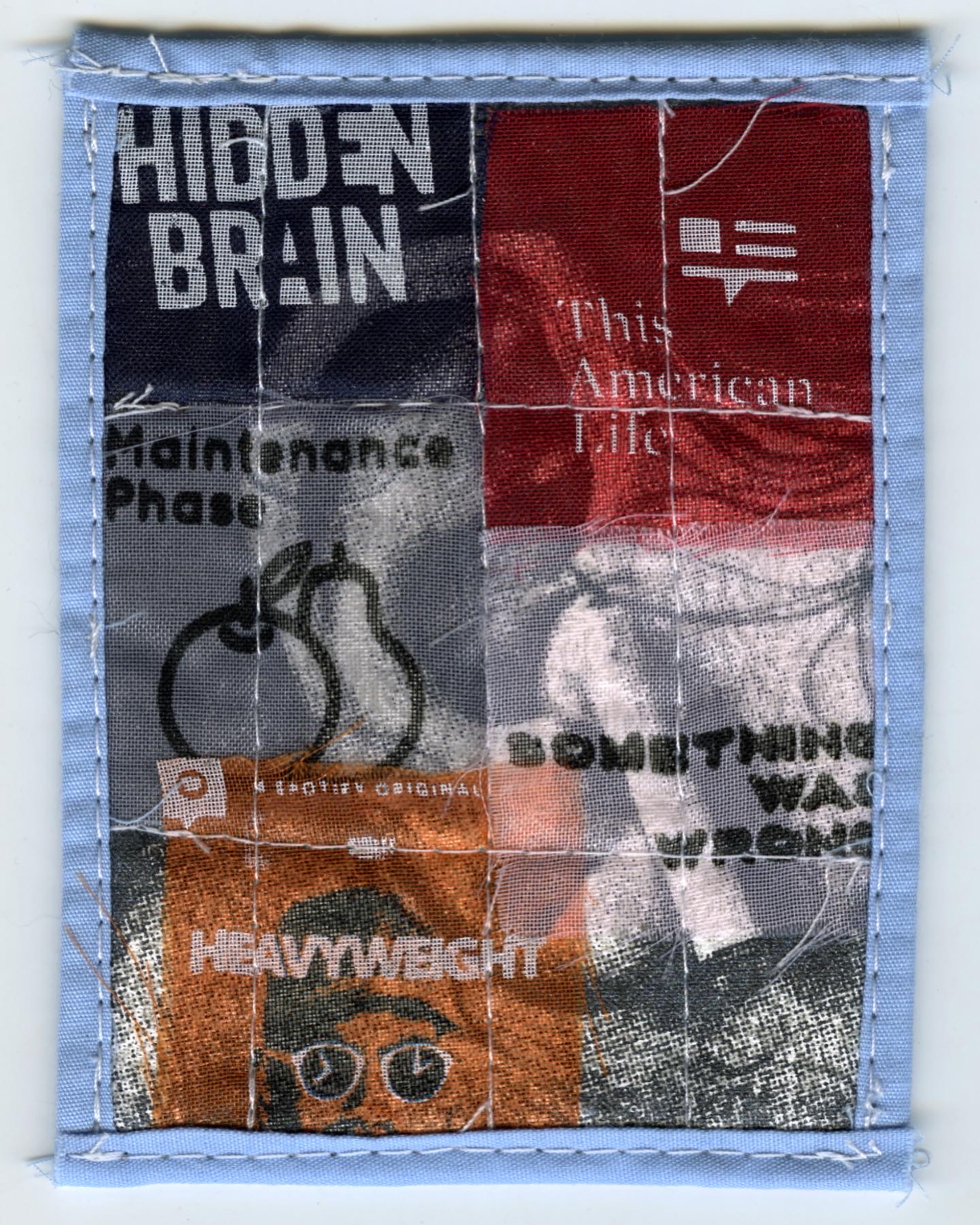
Listen Closely
Screenprint on fabric with appliqué
2” x 3”
2023
B: You earned your MFA from WVU with Joe Lupo. How did your work change in this new environment? How do you feel the graduate experience prepared you for entering a creative career?
SA:
I knew I wanted to go to a school that was not in Texas, I knew I needed a new place that was incredibly different from any prior experience. When arriving in Morgantown, WV to begin my MFA program at WVU I was GOOPED by the incredible mountains and trees. I was in awe of their height and lushness. Being from South Texas, we have a lot of oak trees but they don’t get tall since they don’t experience winter (I assume I am no botanist but I think that’s what I understood). This filled me with the feeling of wonder and I am really inspired by cartoons like Adventure Time, Clarence, Steven Universe, etc. and started thinking about how these stories are set in the normal world we are in and then have a fantastical addition that challenges the main character to have a new perspective about what they’re going through. This felt so significant I was doing something similar where I had a child character with a fantastical world. This didn’t go super far but was my initial experience into making work at grad school. I was so blown away by SEASONS! Fall was incredible, the first day it was 60 degrees out I put on ALL my winter gear because I was so excited to experience something I never had before. My fellow grads and Joe laughed so hard at me…haha it was very funny but I just didn’t know!
Additionally, being at WVU challenged me even further by making me more aware of social political issues I wasn’t aware of. I also met one of my best friends Luca Taylor who taught me about fatphobia and anti-fat bias which I had never considered prior to that. Thinking about how so many insecurities and things we “dislike about ourselves” has a lot to do with systems teaching us to dislike these things made me want to analyze them further. I asked for participants to send me a photo of their face and a list of physical insecurities and physical areas where they felt secure. I then rendered the insecurities in black tonal color pencil and the secure areas with variations of color pencil that was essentially cyan, magenta, yellow, and then brown and tuscan red to push the value. Through doing this and hanging the work together we can see the repetition such as second chins (fatphobia), wrinkles (ageism), eye color (eurocentric) and recognize the systems that taught us to feel poorly about ourselves and knowing that we can push back and possibly come to either a neutral or loving place with those parts of ourselves.
I do feel that attending WVU forced me in a lot of ways to view things differently and I felt like I was finally finding the visual and verbal language to make artwork that felt important to me. I give this credit to Joe Lupo as well as the friends that I was attending school with. Our community made me a better artist and a better person. And it was even stronger than TAMUCC! I was blown away. I still talk to my WVU family regularly including Joe. Joe also had us take a professional practice class that he taught and I felt very prepared after graduating. I also know that if I have any questions I can reach out to Joe and he will be honest and helpful with whatever I am struggling with. Joe loves his students and he is so generous with all of us. I can’t express enough the gratitude I have for him and all he taught me during my time at WVU.
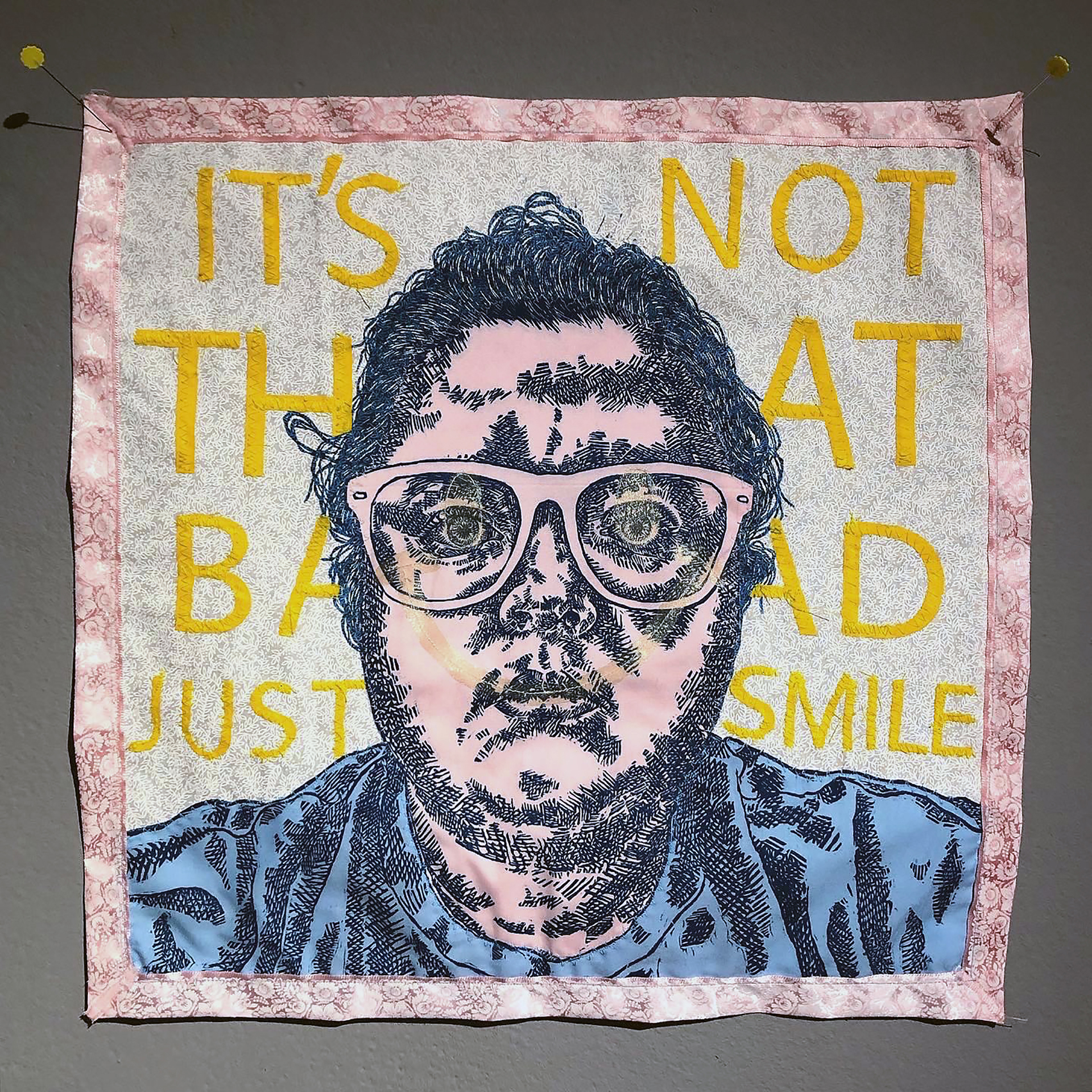
I’m fine, It’s fine.
Relief on fabric with appliqué
12” x 12”
2021
B: You are currently the Gallery and Outreach Director at Emporia State University after several years as a full time adjunct instructor. You also continue to teach Adult Visual Arts workshops at Lawrence Art Center. How did these teaching experiences, combined with assistantships, curatorial and leadership experiences prepare you for your current role at ESU?
SA: After I graduated in 2019 with my MFA from WVU my initial plan was to adjunct at WVU for at least a year but then the few classes I had planned where needed for full time faculty and graduate students so I quickly panicked because I had no plan B! But my really awesome friend Becci Spruill who was finishing her MFA at Kansas State University forwarded me the full time adjunct position that was available at ESU which I interviewed for and got! I was so lucky genuinely as I was planning to just work a job to pay the bills at my Barnes and Nobles job I got during the summer after I graduated. We then quickly packed up and moved our house to Emporia, Kansas in early August and I have been here ever since. The first four years I worked at ESU I was teaching Drawing I, Art Appreciation, and then various levels of printmaking courses. I loved this and felt so fortunate to teach printmaking and was stoked about the community we built during my printmaking courses. My classes and students genuinely felt like a close knit group of friends/family and it was so heartwarming watching them grow during my time as their instructor. During the cuts at ESU that many universities are experiencing I went from full time to part time adjunct with lower pay. I had already been working at Lyon County Noxious Weed and Hazardous Waste Department as part time help and a position opened up there so I could be full time. So I began continuing teaching my ESU courses, working full time at the county, and then I picked up some classes at the Lawrence Art Center. Not certain about what was going to happen to the Art Department at ESU I was considering other options so that my family and I could survive. We then found out that ESU was actually giving more funding to the Art Department, which would then be the Art Program within the School of Visual and Performing Arts. One of the positions that was offered from the restructuring was the Gallery and Outreach Director which would run our Eppink and Gilson Art Galleries, as well as our permanent collection of artwork, and our outreach for the art program + social media. I was hired and have just completed my first year in this position!
While I really miss teaching, I also genuinely love my job. Through this job I have created events for students as community building opportunities which I plan to continue to do. Additionally, I have hung and curated about 8-9 shows this past year. The only way I was able to be ready for this outside of installing my own artwork/solo exhibitions is in grad school I had the incredible opportunity to be the Gallery Assistant in the Laura and Paul Mesaros Galleries at WVU and by working with Shalya Marsh (an incredible ceramics artist look her up!). Shayla taught me so many good tools and was very straightforward about what I did correctly and incorrectly. Her directness meant so much to me and made me a better Gallery Director. As part of outreach we work with fellow outreach directors on campus such as with our planetarium and PAROC (Prophet Aquatic Research & Outreach Center) during their events with schools/children, science Saturdays, and adult events such as the seed swap to combine STEM and art!
I can’t stress enough how scary the uncertain times were while I was at ESU during the restructuring. None of us knew what was going to happen and I applied to a lot of jobs of which I believe I only got two interviews (ESU and somewhere else, I forget) and I thought it was likely I wouldn’t have access to a print studio which is why I reached out to the LAC to try to make sure that if I lost the ESU studio I’d have a backup. I feel fortunate and so lucky for how things ended up working out in the end but I am sad about the struggle so many of us experience to find that forever job or stable job that gives us what we need as artists and people. It’s really tough, honestly.
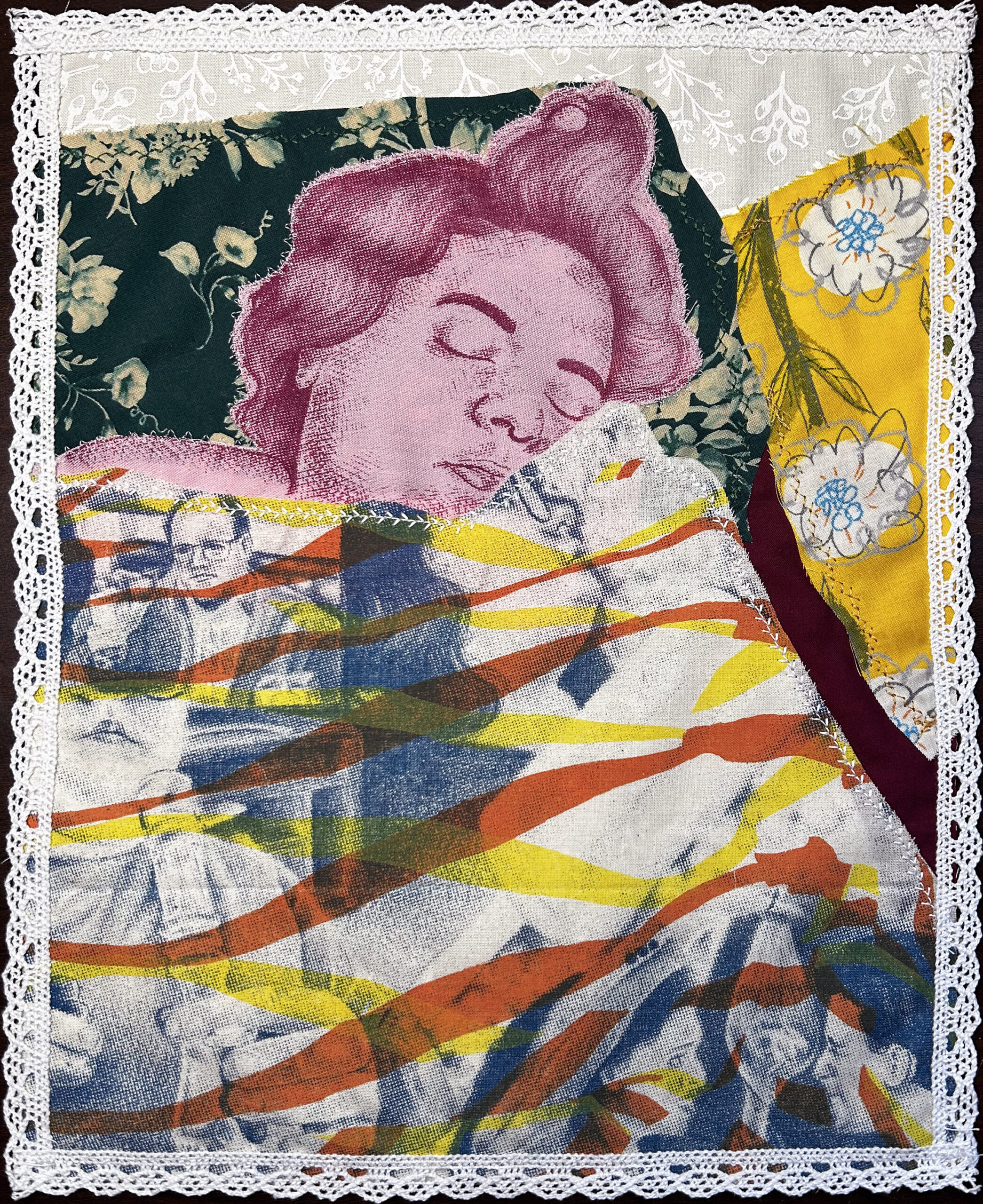
Desperate For a Quiet Mind
(Self-Soothe)
Screenprint on fabric with appliqué
11”x14”
2024
B: What is your current studio practice like? Do you have a space at home dedicated to making? Are you working in the studios at ESU and/or the Art Center? How does studio time/access affect your work/home/relationship balance?
SA: I try to be really honest about this because I feel not enough people talk about moments of flux between making artwork and not being able to make artwork. So since beginning this position I was unable to make any artwork due to the newness of the role, my own learning of how to navigate this role, and balancing my personal life. This role is very demanding and I wear a lot of hats in order to be able to do it and so I tried to be kind to myself during this moment of transition because I had hardly any down time and I really felt burnt out from the stress and uncertainty of where I would be then the joy and excitement and scariness of starting this big new role. I find that these moments of transition are some of the hardest to build a new routine from. With all that being said, I was able to finish a piece I started a few years back during spring break which was so nice. I truly didn’t know how much I needed it. Then I started a few new things once the semester ended in spring and have one and a half of those pieces done as of now!
I feel confident now that I know my job better that I will be able to balance art making, my job, and my personal life. Do I know for sure this will be the reality? No, not really haha. I often am way more optimistic than the reality. I’m hopeful though! And have plans. We recently were able to close on a house and part of that house has a huge “shop” garage that we want to finish and make a comfortable functional studio. Our dream is to create a space that students from ESU would be able to use in between semesters as they lose access to the studio when they aren’t enrolled in courses and the closest studio is in Lawrence, KS. Ideally, it would be accessible to the general community as well. It would also be amazing to offer a residency for either recent undergraduates who have graduated and non degree persons in the country who need an inbetween the next thing they would need to do. This is a ways away but this is our ultimate dream!
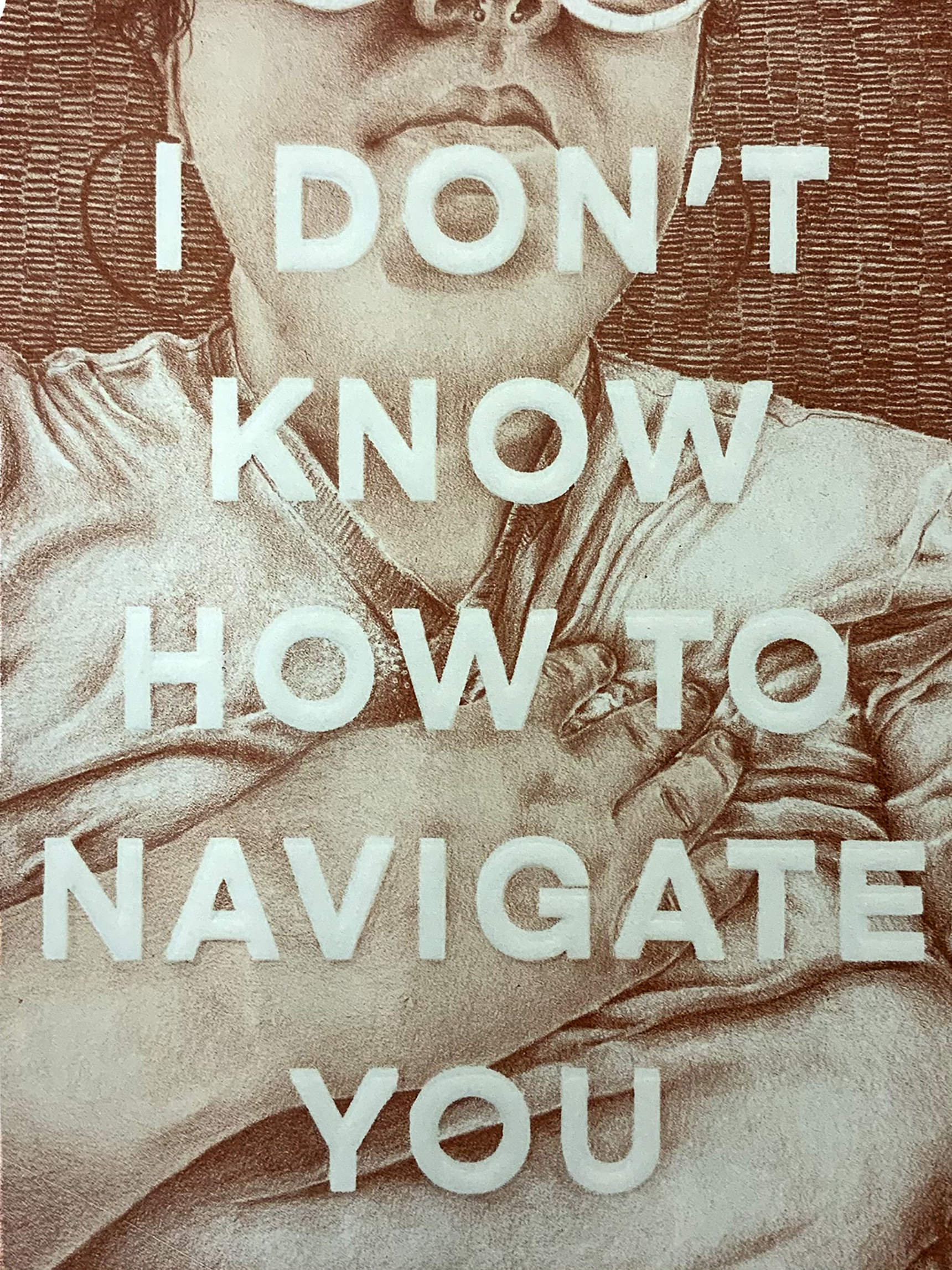
Bad Time Management
Lithograph, screenprint, and embossing
9” x 12”
2021

Alaniz carving at their second job at Lyon County Noxious Weed
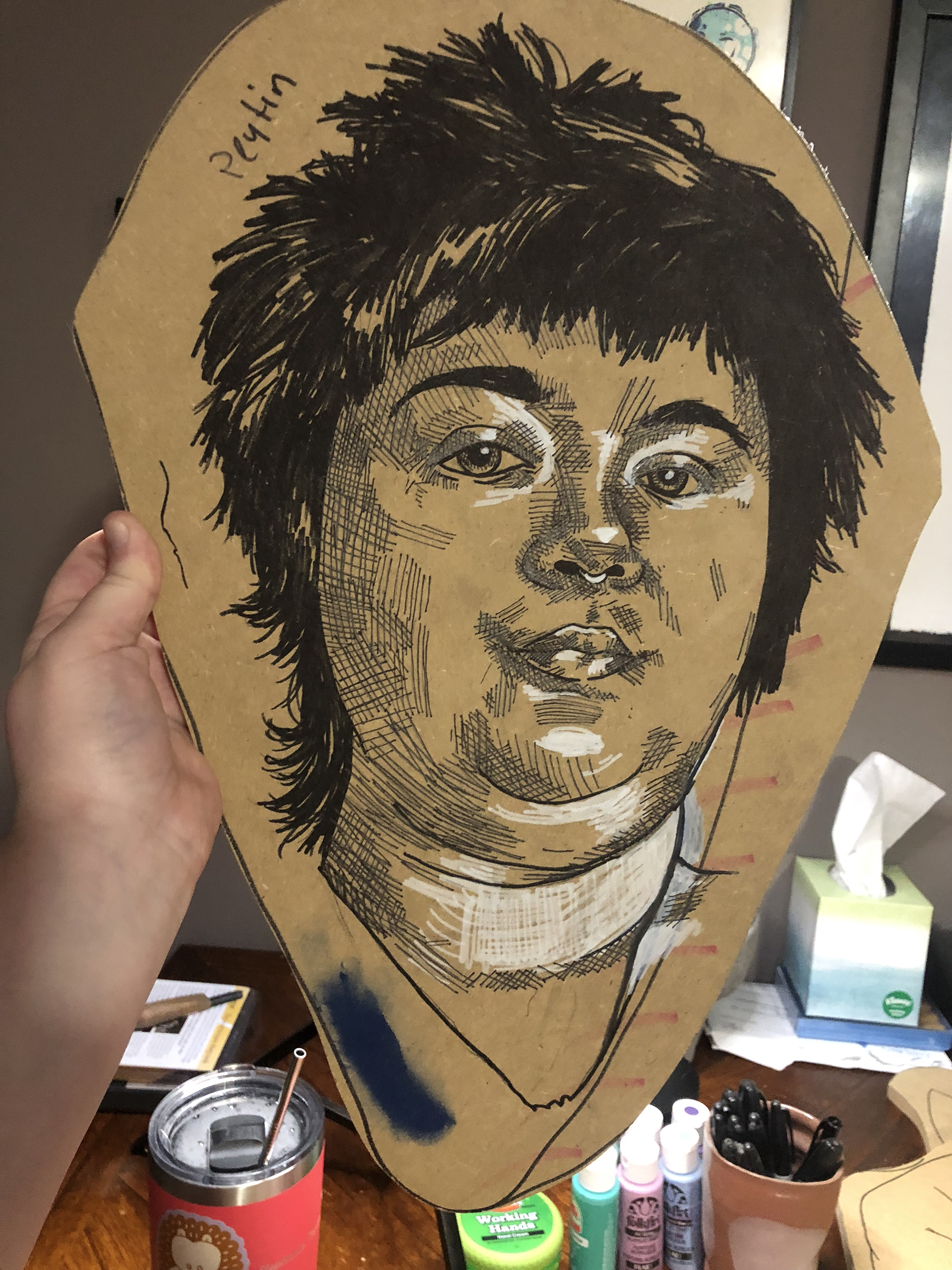
In Progress block of Taking Up
Space: Peytin
B: For as long as I can remember your work has been refreshingly centered in the unvarnished realities of living in a body. Your recent Fat Quilts, for example, have incorporated the coziness of fibers and traditionally domestic craft processes into your print practice. How did you develop the comfort and/or confidence to share your imperfections, insecurities, and mental health issues–and more impressively, convince others to share their own? How do the fibers techniques complement and grow from the emphasis on care evident in your larger oeuvre?
SA: So, I mentioned before having met Luca Taylor who again really challenged my own anti-fat bias and part of that was the insecurity to even call myself fat but also the insecurity of “do people know I am fat?” which is something many young fat people ask themselves I feel. And the answer is, of course! They can see, it’s not something you can “hide”. So thinking about that I started thinking about my other physical insecurities I struggled with. And when I say struggle I mean STRUGGLE. I am a third (possibly fourth) generation of people living with a major anxiety disorder. So when I experience anxiety it is loud and intense and insecurities are definitely one of the loudest. I still struggle with this but its more with who I am and what I say and less about how I look these days. My biggest insecurities at the time were my fatness, my acne, my facial hair, and the places I chose not to shave that were visible such as my armpits and legs. I would be plagued with the constant thought I had before with these things such as “can everyone see all my acne?”, “Can they see my facial hair? My body hair?” etc. So I started considering ways to fight this debilitating anxiety and one of those ways was through making work where I drew myself as I am with the thing that I fear the most on display. Through doing this it felt liberating. No longer did I have to worry if you could see my acne, facial hair, etc. I KNEW you could because I showed it to you by drawing it. Giving it the labor of drawing/printing it also exposed me to it and made me accept it in a way that felt very neutral and freeing. It was so nice not to worry about the fears around what others saw in my body. There were so many critiques I felt like I was going to DIE from the insecurity of it, but the more I did it and the more it was a positive experience the less I feared.
I started feeling like my work isn’t really super accessible in the ways I wanted it to be. Through making my work folks would tell me about how they related to it and I found a lot of comfort in that solidarity and wanted to reach more people and by only doing myself I have such a limited range of identities, like we all do, and began to think of how to reach out to more people. I was nervous to draw anyone else because I didn’t want to harm anyone or perpetuate any insecurities they may have. But I had conversations with people I trust the most and were some of my earliest portraits for my Insecurity Portrait series and decided to make a call for submissions to this series requesting a photo of the individual’s face, a list of physical insecurities they associated with their face, and a list of physical confidences which I would render insecurities in tonal black color pencil and color color pencil for the confidences. Through the repetition of this pattern, plus how the individual was similar to everyone in the series, we could see the systems in place that have cause us to feel insecure and through knowing that take back our power and are given an opportunity to decide if we truly felt that about ourself.
In the last three-ish years I have been thinking more and more about fat acceptance and wanting to make work about fatness. It felt important to critique the cruelty that fat people experience from the world and I was ready to begin talking about it more loudly. I also had been invited by Jun Lee to assist her with a reductive relief workshop at Penland and I was so excited but also nervous because relief was the one process I felt super fearful of. I really didn’t know how to make it work for the type of work that I was interested in making. Taking her class gave me confidence and pushed me out of the fear of failure I was associating for myself with relief. Additionally, Muriel Condon had invited me to a quilt square print exchange! I had created quilts in middle school, they were small and not that interesting but I had a positive relationship with sewing. I decided to do a relief block for this titled I’m fine, It’s fine in which I really wanted to do applique, which was something I had no experience with! I fell in love with the process and started thinking of how I could use it. I started to think about quilts in association to fatness which felt like there was something there. I thought about how spaces are not made with fat bodies in mind. We often have to make ourselves smaller to fit into spaces as well as not offend anyone with our existence from taking up space. Quilts are something that can be quite large, bring comfort, and are soft but also can be folded up to take up less space. For me, this connect was everything! So I made another request because I am drawn to community and making work that is speaking to more people outside of myself. I currently have three completed Taking Up Space series of my fat quilts which is myself, one of my partners, Barbara Lane Tharas, and fellow printmaker Mia Johnson. I have nine total to complete but am excited to do as many as possible! The quilt honestly feels collaborative. The individual provides me a photo of themself, we talk about if they have any attachment to quilt/textile patterns, colors, etc. Through this I make decisions on the individuals quilt. So for example, my quilt has the Sunbonnet Sue pattern which I realized was my earliest memory! I woke up when I was four years old to my quilt covered in Sunbonnet Sue’s and was pink. Remembering that I saw that I even had a stronger connection to quilts. Anyway, Sunbonnet Sue represents being assigned female at birth (AFAB), which I was but I am a non-binary person. I always felt so disconnected from my assigned gender and never felt ‘girl’ enough. She is also kind of chubby in her dress!
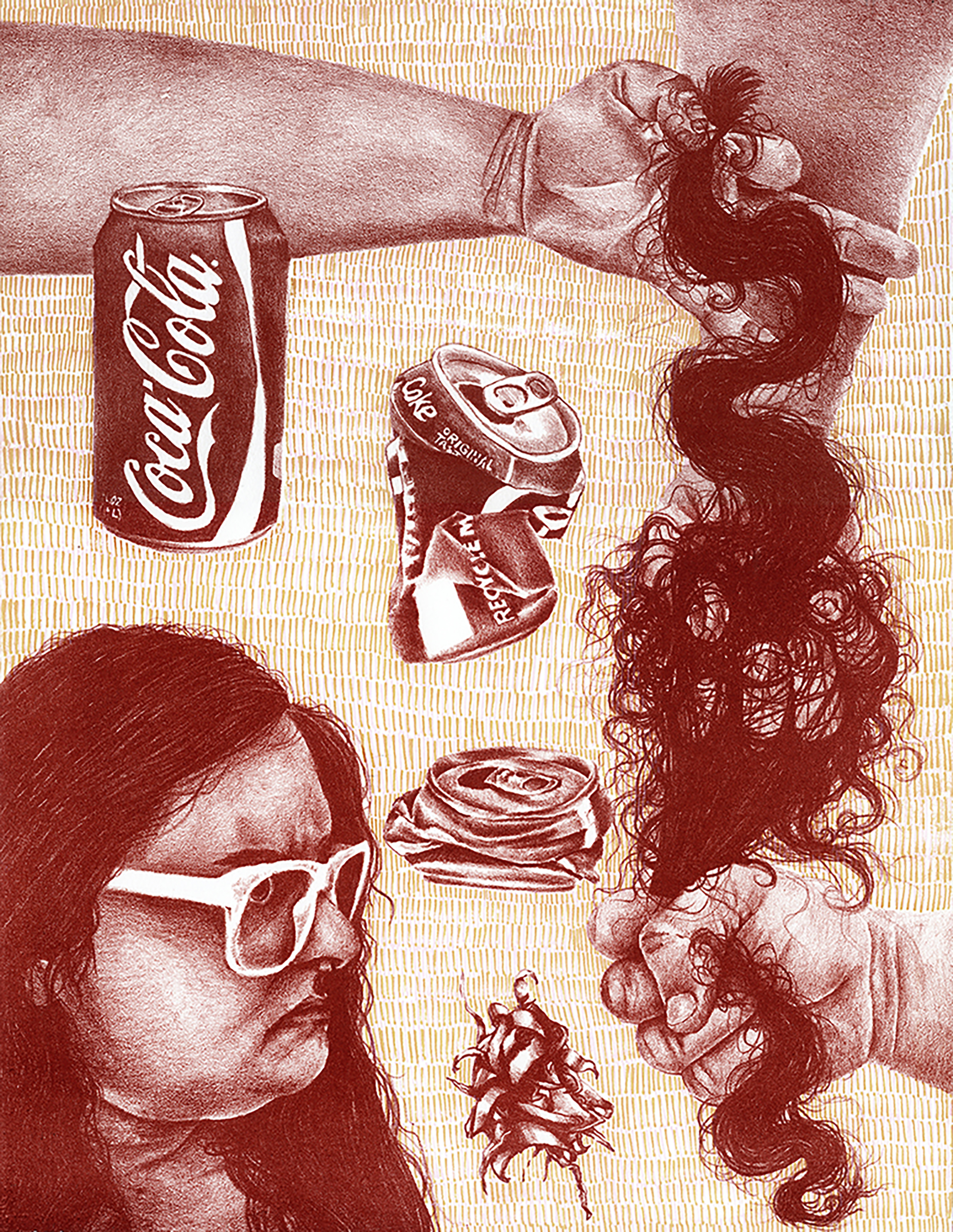
I’m Afraid to Be Like Him
Lithograph and screenprint
11” x 14”
2022
B: How has the radical honesty and exploration emphasized in your work paralleled your coming out as a Queer, non-binary artist? How has finding love and support in your relationship and gender identity affected your work?
SA: Through making the work that I do I find a lot of comfort not only in solidarity of shared experiences but also with community as I mentioned before. I think that the nature of the work I am making and through my own vulnerability a connection is built between myself and the community. Like we can trust each other and through that I feel safer to be more open and honest. Through really honest conversations I have learned to identify in spaces I wasn’t sure I was allowed to occupy like queerness, transness, and fatness. It feels warm to make work that serves these spaces and celebrates the folks who share an experience in this weird life together. It just feels so powerful and special to me.
I mentioned earlier that the objects I was given as a child and how I was treated has a lot to do with the gender that was assigned to me, a girl. Again, I felt so outside of this and ‘wrong’. I had no idea why. Additionally, all my friends were talking about boys being cute or hot and I never felt any of that and was confused how they could look at a person and feel attracted to them. What I know now is that I am queer and more specifically demi-sexual which means I am attracted to a person by our emotional bond or love. I have a husband I have been with for the last seventeen years! We were fourteen when we met and then fifteen when we started dating and I would say and think about how much I loved him and that if he had been any other gender I would have loved him. I knew this was queerness but because I thought I was a girl and he was a boy that this made me straight. That it didn’t matter that I would have loved no matter what identity or sex he was and I could not claim my queerness. It wasn’t until Steven Universe creator Rebecca Sugar shared that they identified as bisexual even though they had been in a straight presenting relationship for over a decade at that point. This blew my mind and changed my perspective completely. I was worried about being called out for a fake and slowly used it to define myself and eventually owned it proudly. Years later, one of my long time best friends and fellow printmaker Barbara Lane Tharas moved in with Joe (husband) and I. I knew that I loved Barbara but that it wasn’t something I could pursue. Later, Joe admitted to me that he loved Barbara too (and also me) and felt guilty about it because we were in a monogamous relationship. I told him it was okay (and that I knew haha) and that I did too but never told him because I knew that it was possible it may hurt him and I never planned to act on it. Anyway, Barbara then tells us that they are in love with us haha! So, we all told each other we liked each other and have been in a closed throuple ever since. And this relationship is not what defines my queerness, I am the one to do that and I would encourage anyone else to remember that no one knows you as good as you know you. Trust yourself, that’s something I didn’t do enough.
Additionally, I don’t think I would have had the courage to identify as non-binary if it weren’t for my students at the time and now friends Dean Fry and Frances Tsounis who encouraged me. I had for a while used she/they pronouns and I would tell people ‘I prefer they but tolerate she’. Both opened my eyes that I didn’t have to tolerate she, I think I just don’t care for myself the way others do so its hard to advocate for myself in the ways I would for someone else. I’m working on this… Anyway, I changed my pronouns on Instagram and felt a wave of support from my friends who promptly noticed and were proud of me living in my truth and advocating for myself. Non-binary is also like a warm blanket, it just feels so right. The other reason it took so long for me to fully come out as a user of they/them pronouns is because I felt that I was too femme to be allowed to use they/them pronouns. Like I was a liar or a fake. Both Dean and Frances assured me this wasn’t the case. I also saw a mug at the time that was by ceramicist Sweeney Brown that said ‘femme’s can be thems too’. MIND BLOWN! After announcing my pronouns and having them used I could feel a wave of comfort from being gendered correctly. It was so affirming.
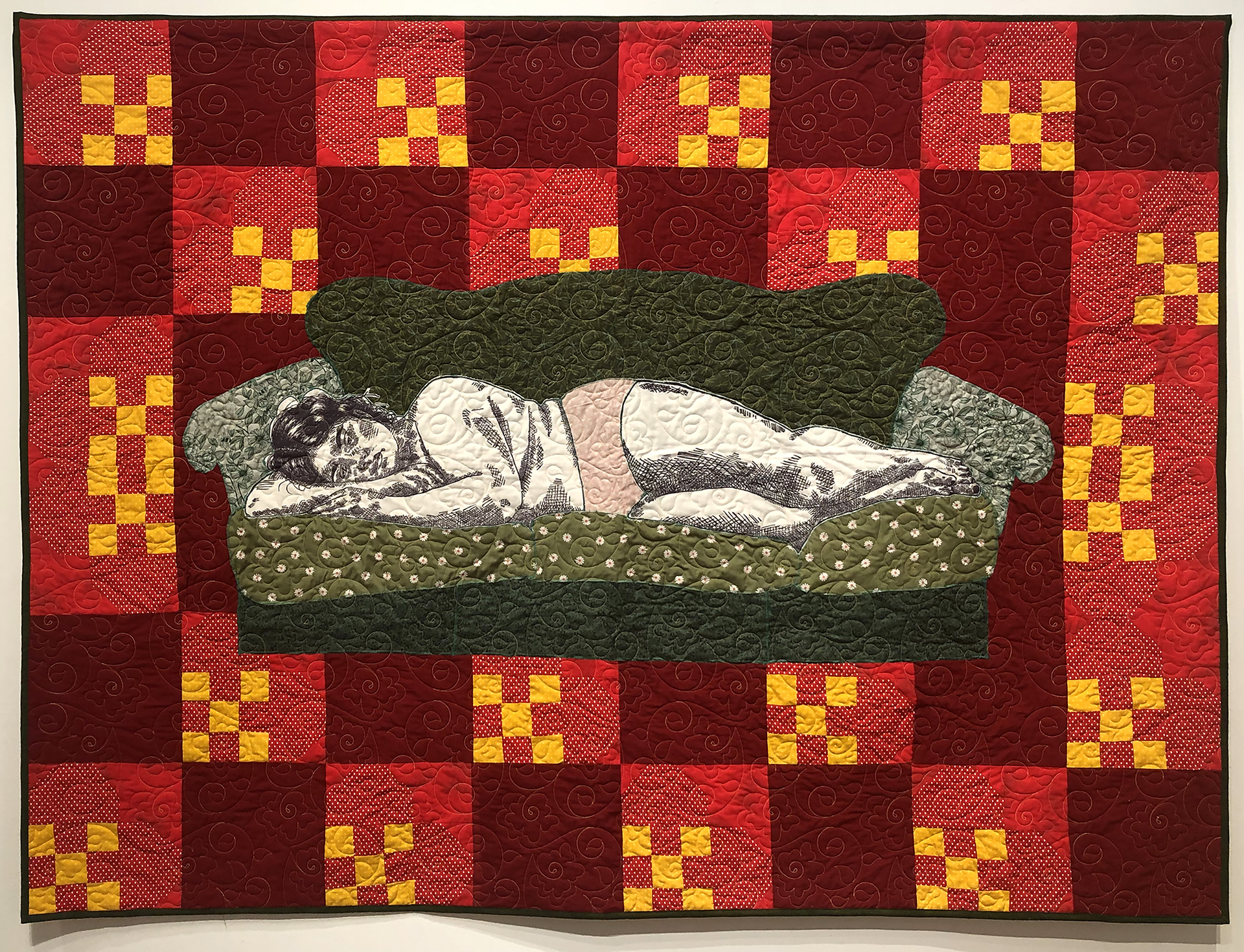
Taking Up Space: Mia
Relief on fabric with appliqué
60” x 80”
2023
B: Where do you see your work and life developing in the next few years? What does success look like for you?
SA: Honestly, refining and building a large collection of textiles, relief/screenprint, and work/research on fatness. I want to continue to speak loudly about fatness and its importance as an identity that deserves kindness and respect. Success would also be this with the addition of having our local print studio with a residency. Having an inclusive space like this feels super important to me. And lastly, finding that balance to where I am giving an even amount of attention and time to all the things that are important to me. Specifically, my art practice, my personal life/mental health, and my job. I really want to thrive in these areas and I am hopeful with time I can do this and help my various communities within the areas and means I am able. That would be perfect, haha.

Taking Up Space: Stephanie
Relief on fabric with appliqué
80” x 30”
2023
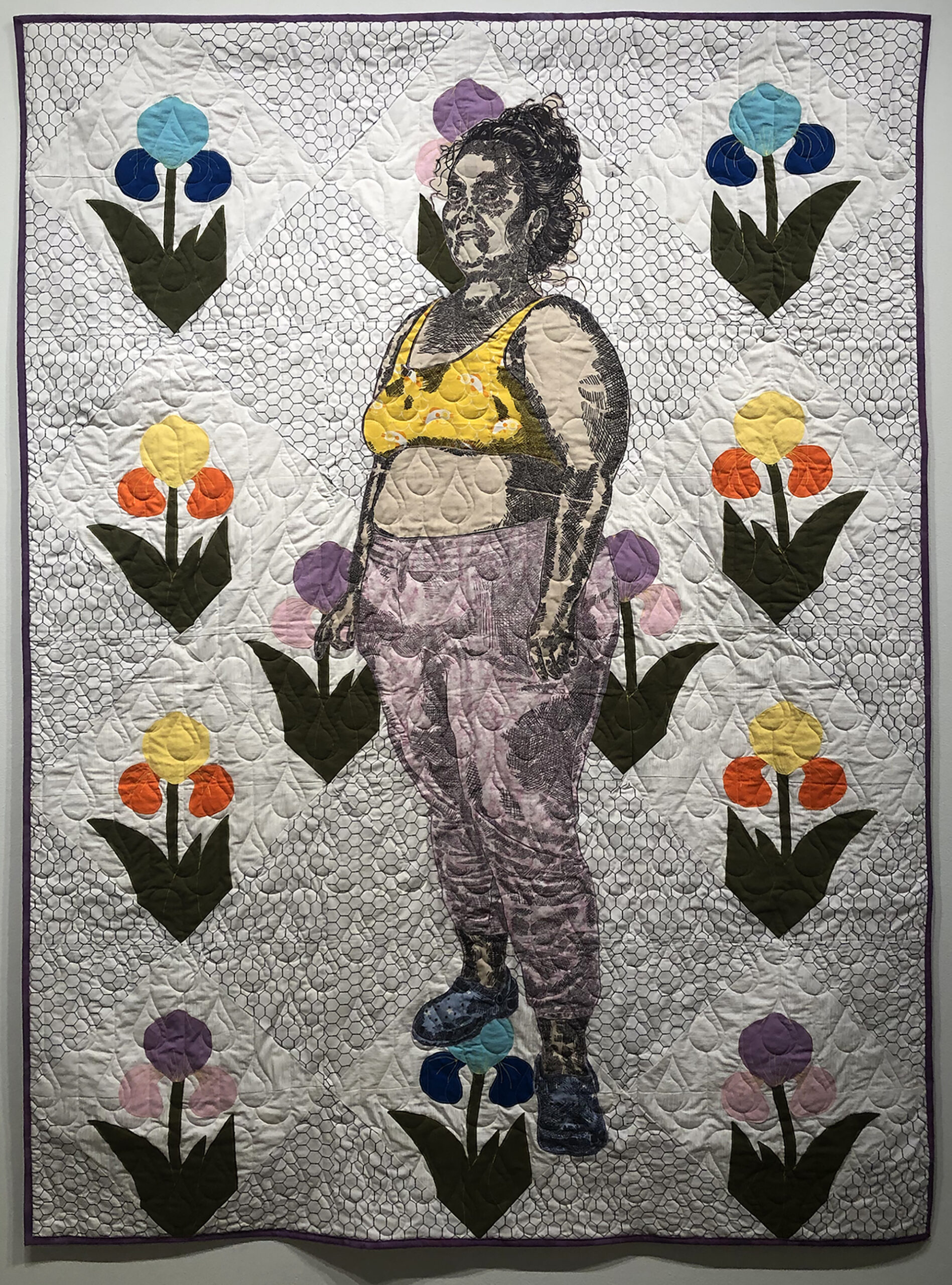
Taking Up Space: Barbara
Relief on fabric with appliqué
80” x 60”
2023
B: What advice would you give current students as they’re about to journey into the wild? What do you wish you’d been told or prepared for by your educational experience or print institutions like SGCI?
SA: Saying no is so important, scheduling fun and down time. You must take care of yourself as much as you possibly can. Saying ‘I don’t know’ is one of the best things I was taught in grad school by Joe Lupo. There is nothing shameful about not knowing something. Most things we don’t know, you know! Avoid pulling all nighters and putting stress on your body like that. It’s easier said than done but find a way to balance all the things in your life. Practicing these habits will help build routine. And I think lastly, trust in your community. The only way I am able to complete ambitious projects is through the help of the people closest to me. They are the ones I can lean on and call on to help me no matter if it’s thoughts about my artwork, helping carve or print, or sewing. Having a team that helps each other is the key to success. I would be lost without the people who have been there for me in this way. Y’all are everything.
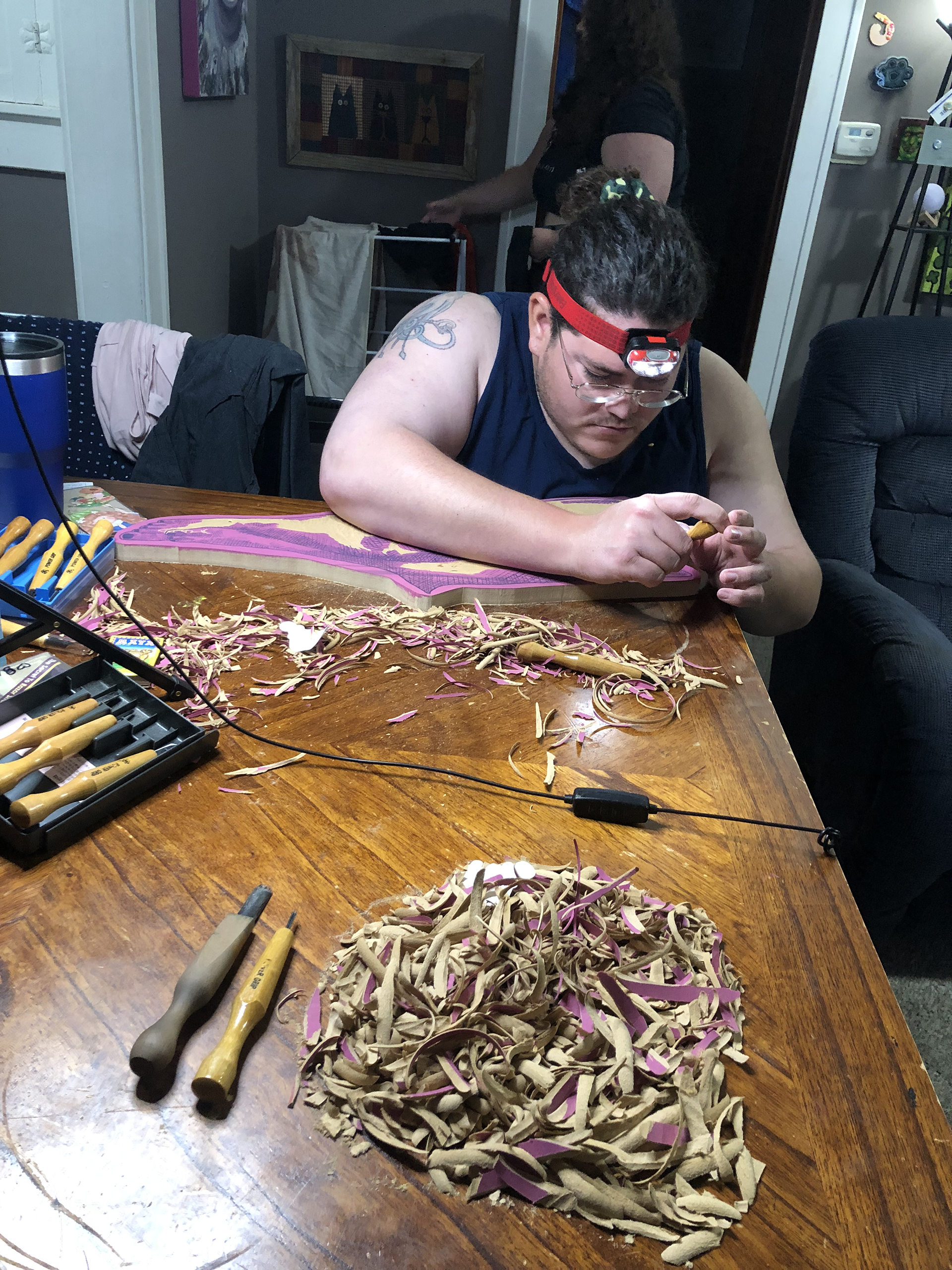
Joe Alaniz (the artist’s husband) helping carve with Barbara Lane Tharas in the background
